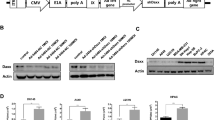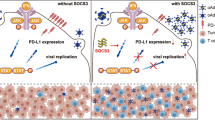Abstract
XAF1 is a newly identified tumor-suppressor gene that can antagonize XIAP and sensitize cells to other cell death triggers. In this study, we utilized ZD55, a conditionally replicative adenovirus (CRAd) similar to ONYX-015 as the vector to transfer XAF1 into the tumor cells to evaluate its antitumor efficacy in vitro and in vivo. Potent and specific cytopathic effect (CPE) was observed upon infection with ZD55-XAF1 in tumor cell lines. Importantly, ZD55-XAF1 exhibited a superior suppression of tumor growth in an animal model of colorectal carcinoma in nude mice compared with Ad-XAF1 (E1-deleted replication-defective viral) and ONYX-015. Complete eradication of the established tumors was observed in four of eight mice. Our data also showed that infection with ZD55-XAF1 resulted in caspase-independent apoptosis. Although caspase-3, poly(ADP-ribose) polymerase were mildly activated in response to ZD55-XAF1 infection, pretreatment with pan-caspase inhibitor hardly influence its apoptosis-inducing activity. In summary, our study strongly suggested that ZD55-XAF1 could serve as an effective gene-virotherapy strategy and has highly potential against human cancers.
This is a preview of subscription content, access via your institution
Access options
Subscribe to this journal
Receive 12 print issues and online access
$259.00 per year
only $21.58 per issue
Buy this article
- Purchase on Springer Link
- Instant access to full article PDF
Prices may be subject to local taxes which are calculated during checkout





Similar content being viewed by others
References
Holcik M, Gibson H, Korneluk RG . XIAP: apoptotic brake and promising therapeutic target. Apoptosis 2001; 6: 253–261.
Hersey P, Zhang XD . Overcoming resistance of cancer cells to apoptosis. J Cell Physiol 2003; 196: 9–18.
Ferreira CG, Epping M, Kruyt FA, Giaccone G . Apoptosis: target of cancer therapy. Clin Cancer Res 2002; 8: 2024–2034.
Chai J, Shiozaki E, Srinivasula SM, Wu Q, Datta P, Alnemri ES et al. Structural basis of caspase-7 inhibition by XIAP. Cell 2001; 104: 769–780.
Suzuki Y, Nakabayashi Y, Nakata K, Reed JC, Takahashi R . X-linked inhibitor of apoptosis protein (XIAP) inhibits caspase-3 and -7 in distinct modes. J Biol Chem 2001; 276: 27058–27063.
Fong WG, Liston P, Rajcan-Separovic E, St Jean M, Craig C, Korneluk RG . Expression and genetic analysis of XIAP-associated factor 1 (XAF1) in cancer cell lines. Genomics 2000; 70: 113–122.
Tamm I, Kornblau SM, Segall H, Krajewski S, Welsh K, Kitada S et al. Expression and prognostic significance of IAP-family genes in human cancers and myeloid leukemias. Clin Cancer Res 2000; 6: 1796–1803.
Liston P, Fong WG, Kelly NL, Toji S, Miyazaki T, Conte D et al. Identification of XAF1 as an antagonist of XIAP anti-Caspase activity. Nat Cell Biol 2001; 3: 128–133.
Byun DS, Cho K, Ryu BK, Lee MG, Kang MJ, Kim HR et al. Hypermethylation of XIAP-associated factor 1, a putative tumor suppressor gene from the 17p13.2 locus in human gastric adenocarcinomas. Cancer Res 2003; 63: 7068–7075.
Ma TL, Ni PH, Zhong J, Tan JH, Qiao MM, Jiang SH . Low expression of XIAP-associated factor 1 in human colorectal cancers. Chin J Dig Dis 2005; 6: 10–14.
Ng KC, Campos EI, Martinka M, Li G . XAF1 expression is significantly reduced in human melanoma. J Invest Dermatol 2004; 123: 1127–1134.
Fang X, Liu Z, Fan Y, Zheng C, Nilson S, Egevad L et al. Switch to full-length of XAF1 mRNA expression in prostate cancer cells by the DNA methylation inhibitor. Int J Cancer 2006; 118: 2485–2489.
Jang JY, Kim HJ, Chi SG, Lee KY, Nam KD, Kim NH et al. [Frequent epigenetic inactivation of XAF1 by promotor hypermethylation in human colon cancers]. Korean J Gastroenterol 2005; 45: 285–293.
Leaman DW, Chawla-Sarkar M, Vyas K, Reheman M, Tamai K, Toji S et al. Identification of X-linked inhibitor of apoptosis-associated factor-1 as an interferon-stimulated gene that augments TRAIL Apo2L-induced apoptosis. J Biol Chem 2002; 277: 28504–28511.
Xia Y, Novak R, Lewis J, Duckett CS, Phillips AC . Xaf1 can cooperate with TNFalpha in the induction of apoptosis, independently of interaction with XIAP. Mol Cell Biochem 2006; 286: 67–76.
Hermiston T . Gene delivery from replication-selective viruses: arming guided missiles in the war against cancer. J Clin Invest 2000; 105: 1169–1172.
Vile RG, Russell SJ, Lemoine NR . Cancer gene therapy: hard lessons and new courses. Gene Therapy 2000; 7: 2–8.
Vorburger SA, Hunt KK . Adenoviral gene therapy. Oncologist 2002; 7: 46–59.
Herrmann M, Lorenz HM, Voll R, Grunke M, Woith W, Kalden JR . A rapid and simple method for the isolation of apoptotic DNA fragments. Nucleic Acids Res 1994; 22: 5506–5507.
Pei Z, Chu L, Zou W, Zhang Z, Qiu S, Qi R et al. An oncolytic adenoviral vector of Smac increases antitumor activity of TRAIL against HCC in human cells and in mice. Hepatology 2004; 39: 1371–1381.
Zhang ZL, Zou WG, Luo CX, Li BH, Wang JH, Sun LY et al. An armed oncolytic adenovirus system, ZD55-gene, demonstrating potent antitumoral efficacy. Cell Res 2003; 13: 481–489.
Abou El Hassan MA, van der Meulen-Muileman I, Abbas S, Kruyt FA . Conditionally replicating adenoviruses kill tumor cells via a basic apoptotic machinery-independent mechanism that resembles necrosis-like programmed cell death. J Virol 2004; 78: 12243–12251.
Srivastava RK . TRAIL/Apo-2L: mechanisms and clinical applications in cancer. Neoplasia 2001; 3: 535–546.
Lockshin RA, Zakeri Z . Caspase-independent cell death? Oncogene 2004; 23: 2766–2773.
Guo Y, Chen C, Zheng Y, Zhang J, Tao X, Liu S et al. A novel anti-human DR5 monoclonal antibody with tumoricidal activity induces caspase-dependent and caspase-independent cell death. J Biol Chem 2005; 280: 41940–41952.
Yang L, Cao Z, Yan H, Wood WC . Coexistence of high levels of apoptotic signaling and inhibitor of apoptosis proteins in human tumor cells: implication for cancer specific therapy. Cancer Res 2003; 63: 6815–6824.
Leist M, Jaattela M . Four deaths and a funeral: from caspases to alternative mechanisms. Nat Rev Mol Cell Biol 2001; 2: 589–598.
Johnson DE . Noncaspase proteases in apoptosis. Leukemia 2000; 14: 1695–1703.
Mathiasen IS, Jaattela M . Triggering caspase-independent cell death to combat cancer. Trends Mol Med 2002; 8: 212–220.
Nemunaitis J, Ganly I, Khuri F, Arseneau J, Kuhn J, McCarty T et al. Selective replication and oncolysis in p53 mutant tumors with ONYX-015, an E1B-55kD gene-deleted adenovirus, in patients with advanced head and neck cancer: a phase II trial. Cancer Res 2000; 60: 6359–6366.
Suzuki K, Fueyo J, Krasnykh V, Reynolds PN, Curiel DT, Alemany R . A conditionally replicative adenovirus with enhanced infectivity shows improved oncolytic potency. Clin Cancer Res 2001; 7: 120–126.
Shinoura N, Yoshida Y, Tsunoda R, Ohashi M, Zhang W, Asai A et al. Highly augmented cytopathic effect of a fiber-mutant E1B-defective adenovirus for gene therapy of gliomas. Cancer Res 1999; 59: 3411–3416.
Wickham TJ . Targeting adenovirus. Gene Ther 2000; 7: 110–114.
Wang L, Hernandez-Alcoceba R, Shankar V, Zabala M, Kochanek S, Sangro B et al. Prolonged and inducible transgene expression in the liver using gutless adenovirus: a potential therapy for liver cancer. Gastroenterology 2004; 126: 278–289.
Yant SR, Ehrhardt A, Mikkelsen JG, Meuse L, Pham T, Kay MA . Transposition from a gutless adeno-transposon vector stabilizes transgene expression in vivo. Nat Biotechnol 2002; 20: 999–1005.
Alemany R, Balague C, Curiel DT . Replicative adenoviruses for cancer therapy. Nat Biotechnol 2000; 18: 723–727.
Wang Y, Hallden G, Hill R, Anand A, Liu TC, Francis J et al. E3 gene manipulations affect oncolytic adenovirus activity in immunocompetent tumor models. Nat Biotechnol 2003; 21: 1328–1335.
Acknowledgements
We thank Douglas W Leaman (The University of Toledo, USA) for the provision of pcDNA3-HA-XAF1 plasmid. We also thank Lanyin Sun for help in the cell culture, Ming Zhuo and Yanhong Zhang for discussion of this paper. This work was supported by the Key Project of the Chinese Academy of Sciences (No. KSCX2-3-06), the National Natural Science Foundation of China (No. 30120160823), a Chinese National b863Q High Tech Project Foundation grant (No. 2002AA216021), the 973 Project (No. 2004CB518804).
Author information
Authors and Affiliations
Corresponding author
Rights and permissions
About this article
Cite this article
Qi, R., Gu, J., Zhang, Z. et al. Potent antitumor efficacy of XAF1 delivered by conditionally replicative adenovirus vector via caspase-independent apoptosis. Cancer Gene Ther 14, 82–90 (2007). https://doi.org/10.1038/sj.cgt.7700992
Received:
Revised:
Accepted:
Published:
Issue Date:
DOI: https://doi.org/10.1038/sj.cgt.7700992
Keywords
This article is cited by
-
Synergistic suppression effect on tumor growth of hepatocellular carcinoma by combining oncolytic adenovirus carrying XAF1 with cisplatin
Journal of Cancer Research and Clinical Oncology (2015)
-
Aspirin enhances IFN-α-induced growth inhibition and apoptosis of hepatocellular carcinoma via JAK1/STAT1 pathway
Cancer Gene Therapy (2013)
-
Assessment of XAF1 as a biomarker to differentiate hepatocellular carcinoma from nonneoplastic liver tissues
Chinese Journal of Cancer Research (2012)
-
Down-regulation of the pro-apoptotic XIAP associated factor-1 (XAF1) during progression of clear-cell renal cancer
BMC Cancer (2009)
-
Armed replicating adenoviruses for cancer virotherapy
Cancer Gene Therapy (2009)



